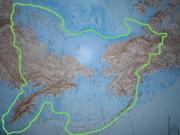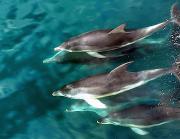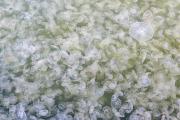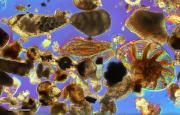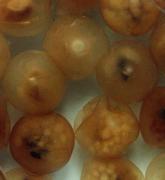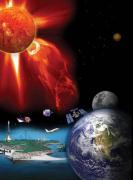Radio Program
Our regular Science and the SeaTM radio program presents marine science topics in an engaging two-minute story format. Our script writers gather ideas for the radio program from the University of Texas Marine Science Institute's researchers and from our very popular college class, Introduction to Oceanography, which we teach to hundreds of non-science majors at The University of Texas at Austin every year. Our radio programs are distributed at to commercial and public radio stations across the country.
You’ll find lots of hiking trails along the western coast of the United States. But archaeologists are looking for one more. It might have been hidden for thousands of years -- on the bottom of the Pacific Ocean.
There’s evidence that the first people reached the Americas perhaps 15,000 years ago or even earlier. They came during the last Ice Age, when sea level was hundreds of feet lower than it is today. That exposed a “bridge” of land between present-day Asia and Alaska. People might have crossed that bridge in search of game or other necessities.
Some of the bottlenose dolphins near the town of Laguna, Brazil, seem to have a pretty good thing going. The dolphins herd schools of fish toward spots along the shore. At a signal from the dolphins, fishermen drop their nets into the water. The people trap some of the fish in their nets, while the dolphins get the rest. It’s one of a handful of known examples of humans and wild dolphins working together.
There are lots of ways to cause a blackout -- storms, mechanical failures, even explosions on the Sun. You can also do it with a few truckloads of jellyfish.
There are more than 1500 species of jellyfish. Many of them are both delicate and beautiful. Even so, the jellyfish can be quite a pest. It can deliver a nasty sting or decimate a fish population. And if you get enough of them, they can shut down major pieces of equipment -- especially power plants.
Life on Earth is a bit like a boxer who can take a few punches but still win the fight: It can be knocked around, but it’s hard to knock out.
Consider a punch delivered about 65 million years ago. A space rock the size of a city slammed into the Gulf of Mexico, off the Yucatan peninsula. Among other things, that blasted enough debris into the atmosphere to blot out the Sun around the entire planet. That killed off about three-quarters of all species of life -- including the dinosaurs. But life rebounded -- even at the site of the impact.
People often make fun of the phrase “jumbo shrimp,” as if anything called a shrimp could also be jumbo. What’s really funny, though, is the name of a relative of the shrimp: the giant ostracod. This odd critter is no bigger than a meatball. It’s “giant” only in comparison to other ostracods, which can be as tiny as a poppy seed.
Bad weather can make it hard to navigate. It’s hard to see where you’re going if there’s fog or heavy rain, so you can find yourself off course and in trouble.
For a while, biologists have suspected that bad weather can make it hard for whales and dolphins to navigate, too -- not fog and rain, but space weather. Space weather is caused by magnetic storms on the Sun. Giant eruptions can spray Earth with energy and charged particles. That can disrupt satellites, interfere with radio communications, and knock out power grids.
Pass the salsa and the bean dip, please! It’s time to try the latest chips. They’re crunchy and healthy. There’s just one little catch: They’re made from jellyfish.
Few people in the west clamor for jellyfish. The slimy texture just isn’t very popular. And many people know that jellyfish tentacles can contain some nasty venom, which hardly helps its reputation.
In Asia, though, jellyfish are a delicacy. Their bodies, known as bells, are brined for several weeks in a combination of salt and alum. That dries the jellyfish out, giving them the texture of a pickle.
Plastic junk floats atop all the world’s oceans -- cups, bottles, wrappers, bags, and a thousand other products. These bits of trash can be found just about anywhere, drifting with the currents. And sometimes, they travel in clumps -- perhaps pulled in by small whirlpools.
One of the sleekest-looking dolphins is also one of the most elusive. It inhabits far-southern waters, where there are few people around to enjoy its beauty. Because of that, it faces fewer threats from fishing fleets and other hazards.
The hourglass dolphin is named for its unique coloring. Its body is black with a pair of white stripes down its sides. The pattern creates the look of an hourglass.
For some, “getting away from it all” might mean a trip to the South Pacific -- some delightful tropical island far from the cares of everyday life. But really getting away from it all means going to a point in the South Pacific where there are no islands within almost 1700 miles. It’s the point on the globe that’s farthest from any land, known as Point Nemo.

